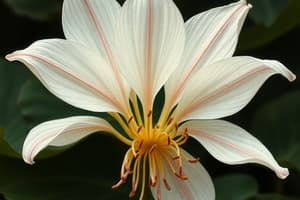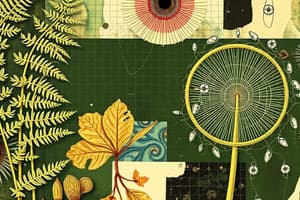Podcast
Questions and Answers
What is the function of the stigma in a flower?
What is the function of the stigma in a flower?
- To produce ovules
- To receive pollen (correct)
- To protect the receptacle
- To support the style
What is the term used to describe the collective parts of the calyx and corolla?
What is the term used to describe the collective parts of the calyx and corolla?
- Perianth (correct)
- Receptacle
- Involucre
- Tepal
What is the purpose of the bracts in a flower?
What is the purpose of the bracts in a flower?
- To produce pollen
- To subtend the flowers (correct)
- To support the stamens
- To protect the ovules
What is the meaning of the term 'tepals' in botany?
What is the meaning of the term 'tepals' in botany?
What is the function of the receptacle in a flower?
What is the function of the receptacle in a flower?
What is the least affected by changes in the environment in flowering plants?
What is the least affected by changes in the environment in flowering plants?
What is the complete sexual cycle in flowering plants?
What is the complete sexual cycle in flowering plants?
What is the function of the receptacle in a flower?
What is the function of the receptacle in a flower?
What is the collective term for the stamens in a flower?
What is the collective term for the stamens in a flower?
What is the function of the sepals in a flower?
What is the function of the sepals in a flower?
What is the term for the central whorl of modified floral leaves in a flower?
What is the term for the central whorl of modified floral leaves in a flower?
What is the term for the entire structure formed by one or more united carpels?
What is the term for the entire structure formed by one or more united carpels?
How many whorls of modified leaves make up a typical flower?
How many whorls of modified leaves make up a typical flower?
Flashcards are hidden until you start studying
Study Notes
Flower Morphology and Sexual Reproduction
- Flowers and fruits are the least affected by environmental changes, making them important for angiosperm classification.
- The essential steps of sexual reproduction in flowers include: meiosis, pollination, fertilization, fruit and seed development, seed and fruit dissemination, and seed germination.
Flower Structure
- A typical flower consists of four whorls of modified leaves: sepals, petals, stamens, and carpels, all attached to the receptacle.
- Sepals enclose the other flower parts in the bud and are generally green.
- Petals are the conspicuous, colored, attractive flower parts, collectively known as the corolla.
- Stamens form a whorl, lying inside the corolla, and consist of a slender stalk (filament) and an anther.
- The whorl or grouping of stamens is called the androecium.
- Carpels comprise the central whorl of modified floral leaves, known as the gynoecium.
Pistil and Receptacle
- A pistil may be composed of a single carpel or several united carpels in the center of the flower.
- A pistil consists of three distinct parts: the ovary, style, and stigma.
- The ovary contains ovules, the style supports the stigma, and pollen is deposited on the stigma.
- The receptacle is the enlarged end of the flower stem or stalk to which the sepals, petals, stamens, and pistils are attached.
Additional Terms
- The term perianth refers to the calyx and corolla collectively.
- A tepal refers to an individual part of the perianth, often used to describe flowers with morphologically indistinguishable calyx and corolla.
- An involucre is a collection of bracts that subtend flowers or compact clusters of flowers.
Studying That Suits You
Use AI to generate personalized quizzes and flashcards to suit your learning preferences.




